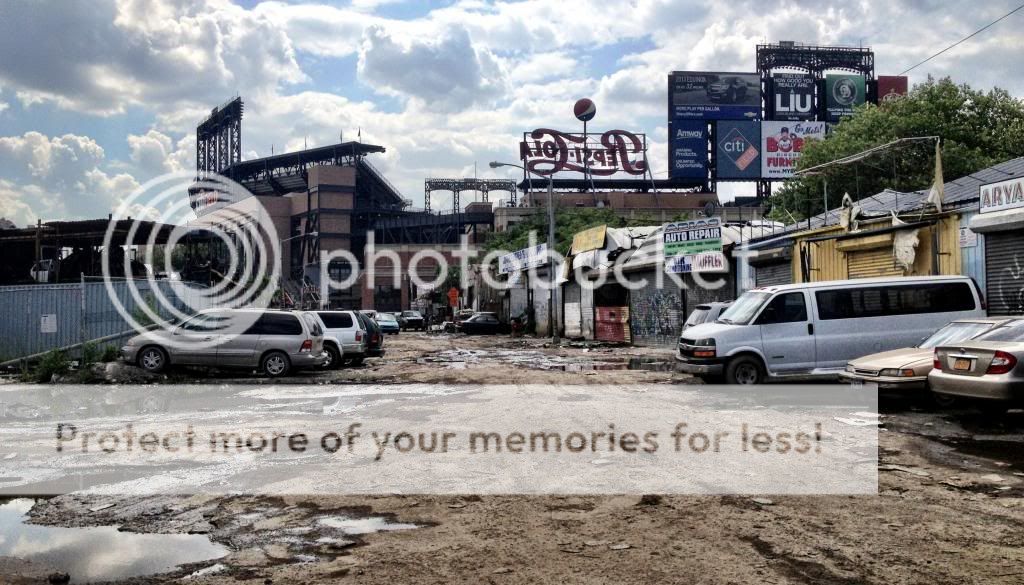Bloomberg’s New York: Building For The Future, The Case of Willets Point
Bloomberg’s New York: Building For The Future, The Case of Willets Point
If you walk along the main entrance of the Met's new ballpark, you'll see a cluster of auto-body repair shops and junkyards along unpaved, dirt roads. The buzz of drills hitting metal fill the air as repairmen and cars move in and out of the 62-acre section bordering 126th street.
Willets Point, also known as “The Iron Triangle” or “The Valley of Ashes”, is one of over 60 sites across the five boroughs the Bloomberg Administration has paved the way for development. During Bloomber's tenture, The New York City Economic Development Corporation has focused most of its development efforts on revitalizing underused or dilapidated spaces into new public, commercial or residential spaces that will spur economic activity and improve the cityscape for future generations.
But Willets Point is also the site of a contentious battle that pits the benefits of future development against the needs of longtime residents and business owners who see the changes as a direct threat to their livelihood.
Back in 2008, Mayor Bloomberg said he wanted to transform the area into a mix-use neighborhood of shops, apartments and affordable housing. It was to become New York City’s first green neighborhood. That November, the City Council approved a plan to create the Willets Point Urban Renewal Area authorizing the redevelopment plan. Since then, the city has bought-out or acquired 95 percent of the land needed for developer and Mets owner Sterling Equities. Since most of the business owners are commercial tenants, the EDC has dealt exclusively with the landlords to acquire the property, but many of the shop-owners and workers have accused the city of unfairly evicting businesses for the project.
“See, they closed all of these things. The shop with the red gate, he was there all morning. He has to get his stuff out,” Chris Cannali said pointing to a row of shuttered shops. Cannali has worked at Willets Point for over 20 years. “What they do is come and say the buildings are unsafe, some they just condemn.”
Most of the businesses are immigrant owned and decades old. The EDC has hired the consulting group, Cornerstone to help relocate affected auto-shops. It has also set up the Willets Point Workers assistant program. At the most recent New York City Planning Commission hearing, EDC Senior Vice President of development David Quart testified that over 600 workers have applied for the program, while 470 workers have already taken advantage of the vocational skill training, ESL computer classes and other programs.
But many like Weiss Mohibi, owner of Discount Mufflers, don't want to leave.
“Where am I going to go?” Mohibi said he has had a hard time finding a similar location where there are a cluster of shops that do everything from selling used car parts to basic mechanical repairs. “ I’ve been searching, there’s nothing. Places are bad, and also expensive and bad location.”
Mohibi said his customers come from all over the tri-state area because they can get repairs done there at a competitive rate. Something he said has been especially important since the economic downturn. “After 2008, people say thank God Willets Point exists here,” he said. “This area should be more important than it used to be, because of the economy. A lot can’t afford to spend double.”
Critics are also concerned that plans for affordable housing won’t move fast enough under the current proposal.
When Mayor Bloomberg announced Sterling Equities would take over the project in 2012, the plan called for 2,500 units of affordable housing. But developers and the EDC agree the project must happen in phases: first retail, then an expressramp of the Van Wyck Expressway, and finally housing.

“There is no there, there in terms of a neighborhood,” EDC Senior Vice President of development David Quart testified when asked why the housing portion would be delayed. “So cleaning up the site initially, and then creating an economic engine to establish this environment is really key first, and that will take several years.”
Construction is expected to generate over $310 million in tax revenue, and once the project is fully operational, it is expected to bring in over $150 million in new annual revenue.
Under the current proposal, phase one is scheduled to be completed by 2018. Developers will turn 23 acres of the Special Willets Point District into a 200-room hotel, 30,000 square-feet of retail space, and a 2,8000 space surface parking lot. To the west, where the CitiField parking lot is currently located, developers will add a 1.4 millionsquare foot entertainment and retail center and a 2,900-space parking lot. By 2028, the surface parking lot of the Special Willets Point District will be replaced with 4.23 million square-feet of residential, retail, office, and hotel space, along with a public school, enclosed parking, and open public space. The full project won’t be completed until 2032.
“Had it been stated back in 2008 that the affordable housing would be put off for 10 years, this plan would have never been approved” David Schwarts of Willets Point United, an organization that represents the businesses owners, said outraged at the public hearing. “This is a bamboozle going on here.”
Once the plan is done (The Special Willets Point District)) Source: The New York City Economic Development Corporation







